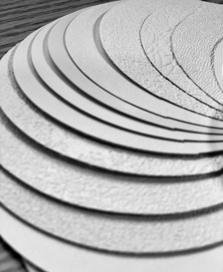Considerations When Buying Wallpaper
While regular wallpaper adds wall longevity and durability, custom wallpaper also lets customers add a personal touch to their wall space. Various embossments take this personalization a bit further by adding subtle texture and depth – achieving greater visual interest than pressure sensitive vinyl.
Installation varies from PSV, so we recommend using a wallpaper installer for precise installation. Wallpaper installers are usually easy to find, but sometimes go by other names like wallpaper hanger or paperhanger. A lot of painters will also be able to install wallpaper.

Wallpaper should be installed with a buttseam rather than an overlap, which is the usual for PSV installation. A buttseam is a seam in which wallpaper strips meet exactly, edge to edge, without overlapping.
Wallpaper installers know how to apply wallpaper with a buttseam, but it is possible to install wallpaper with an overlap if the installer is very good with a knife. An overlap seam is a seam in which the edges of the wallpaper are overlapped slightly. The excess will need to be cut away afterwards, so a straight edge is crucial. Unlike PSV (which tends to be more movable, stretchy, and forgiving), wallpaper will not stretch.
Q: Why does my sales rep need to know what installer we’re using?
A: We need to make sure that the graphic is tiled, printed, and cut properly depending on the install technique (overlap or buttseam) that the installer will be using.
Traditional wallpaper keeps a crease forever if folded, but our pvc-based wallpaper will not have this issue. Though durable, wallpaper is not necessarily scuff-resistant – mild abrasion can occur.
Wallpaper is better for long-term use. It’s woven so it’s more like a fabric. The backside texture (scrim) helps adhesion with the paste. Since we sell pvc-based wallpaper, removal is easier than traditional paper. This wallpaper strips from the wall in full sheets when it is time to redecorate. Just pull up a corner and take the wallpaper strip off the wall without having to steam or get out other tools. Wallpaper paste residue must be removed from the wall before applying new wallpaper or painting the wall.




